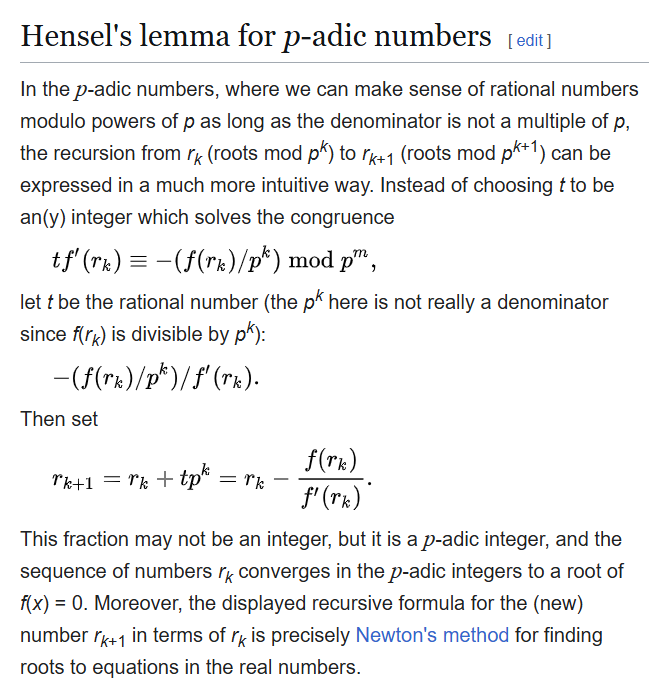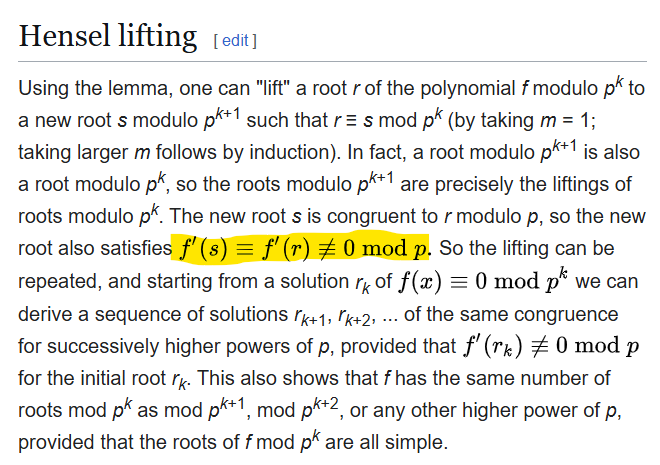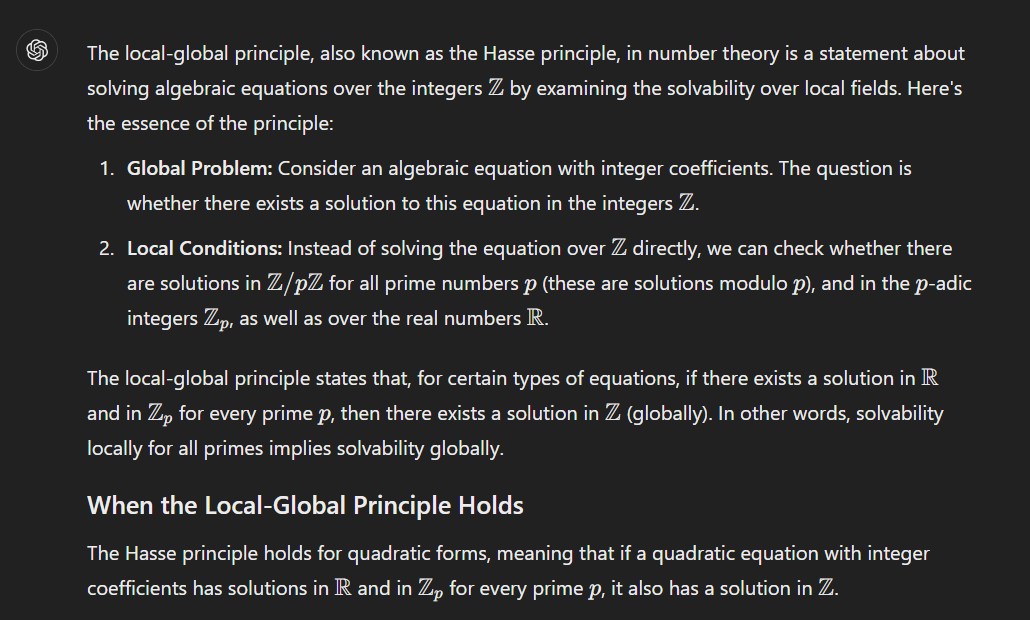那咋办?敲敲脑袋?
找出定理,看它证明,或者找几个简单例子,能不能解决问题?
版主: verdelite, TheMatrix


也就是考虑 f(x)=0 mod pn,先考虑单变量x。TheMatrix 写了: 2024年 11月 15日 10:42 ring homomorphism Φ: R --> S 可以推出
1,代数方程 f=0 over R 可以看作代数方程 f=0 over S。
2,代数方程 f=0 over R 有解 (x,y),那么代数方程 f=0 over S 一定有解 (Φ(x),Φ(y))。
但是反过来不行,代数方程 f=0 over S 有解,不一定能推出代数方程 f=0 over R 有解。
反过来叫lift。也就是代数方程 f=0 over S 的解,什么情况下能lift到代数方程 f=0 over R 的解。
如果Φ不是surjective的话,如果over S的解不在Φ的image当中,那肯定不能lift回去。
所以简单情况:Φ是surjective ring homomorphism。
比如 Φ: Z/p2Z --> Z/pZ。这就是Hensel Lemma要考虑的问题。

mod p --> mod p2可以了。TheMatrix 写了: 2024年 11月 15日 11:18 也就是考虑 f(x)=0 mod pn,先考虑单变量x。
已知 f(x1)=0 mod p (x1是 mod p 的解)。
要找到 f(x2)=0 mod p2 (x2是 mod p2 的解),并且 x2=x1 mod p。
据说条件应该是 f'(x1) != 0 mod p,也就是导数不等于0。

不对。检查了一下,发现条件应该是这样的:TheMatrix 写了: 2024年 11月 15日 12:09
所以一个mod p的解,要想能一级一级lift到mod pn的解,条件应该是:
f'(x1) != 0 mod p
f'(x2) != 0 mod p2
f'(x3) != 0 mod p3
....

x1 --> x2得到的是:TheMatrix 写了: 2024年 11月 15日 14:23 不对。检查了一下,发现条件应该是这样的:
f'(x1) != 0 mod p
f'(x2) != 0 mod p
f'(x3) != 0 mod p
...

就是wiki上的这一小段:TheMatrix 写了: 2024年 11月 15日 14:48 x1 --> x2得到的是:
npf'(x1)+f(x1)=0 mod p2
注意f(x1)=0 mod p,但是f(x1)不一定等于0 mod p2,也就是f(x1)有p因子但是不一定有p2因子。所以上面式子可以解出n:
n = - (f(x1)/p) / f'(x1)
这是在Z/pZ中,也就是在一个域中解出。然后,x2=np+x1。
x2 --> x3得到的是:
np2f'(x2)+f(x2)=0 mod p3
可以解出n in [0,1,...,p-1]:
n = - (f(x2)/p2) / f'(x2)
这还是在Z/pZ中解出。然后x3=np2+x2
...
似乎还是要递归,并不能一下子得出可以lift到所有mod pn的结论。


有了。TheMatrix 写了: 2024年 11月 15日 14:23 不对。检查了一下,发现条件应该是这样的:
f'(x1) != 0 mod p
f'(x2) != 0 mod p
f'(x3) != 0 mod p
...


我顶楼的问题是:一个代数方程,在任意 mod pn 下有解,那么就在 Zp 有解。FoxMe 写了: 2024年 11月 15日 16:03 Hensel's lemma就是牛顿法求根。它是否说明多项式方程在Z7有解等价于其在F7上有解?
Hensel's lemma与顶楼的问题有关吗?
“给定素数p,比如p=7。一个代数方程,比如 x2+y2=5,如果mod 任意 7n有解,那么就在Z7(7-adic integer)下有解。这个对吧?”

我看到的表述是:二次方程在Z上有解当且仅当在所有Zp上有解以及在实数域上有解。FoxMe 写了: 2024年 11月 15日 16:07 这个问题应该这么问:
对于二次方程,local-global principle说在Q上有解当且仅当在所有Qp上有解。
那么对于二次方程,“在Z上有解当且仅当在所有Zp上有解”是否成立?为什么?

我是在ChatGPT上看到的。ChatGPT在较真的时候确实不是特别可信。FoxMe 写了: 2024年 11月 16日 09:34 有的书上偷懒,就把实数域写作Zp for p=infinity.
在哪儿看到的?这是不对的,local-global在Q上成立,Z上不一定:
https://kconrad.math.uconn.edu/blurbs/g ... global.pdf
Example 3.1. Consider x2 + 11y2 = 3. It obviously has no integer solutions, but has a solution in R and each Zp. Solvability in R is clear, and solvability in Zp for p ̸= 2 or 11 follows from solving the congruence x2 ≡ 3 − 11y2 mod p using the pigeonhole principle (as in the proof of Theorem 2.4) and then applying Hensel’s lemma.
To prove solvability in Z2, from 3/11 ≡ 1 mod 8 we see that 3/11 is a square in Z2, so we can solve 02 + 11y2 = 3 in Z2.
InZ11,since3≡52 mod11wecansolvex2+11·02 =3inZ11.
但是为啥会不成立呢?按理说,根据中国余数定理,Z上是否成立等同于模pm是否成立。是不是在中国余数定理中,素因子的个数是有限的,而这里p的个数是无限的?


那按你的说法,这个方程 x2+11y2=3 在Q上有解,也就是有有理数解。你找到有理数解了吗?FoxMe 写了: 2024年 11月 16日 09:34 有的书上偷懒,就把实数域写作Zp for p=infinity.
在哪儿看到的?这是不对的,local-global在Q上成立,Z上不一定:
https://kconrad.math.uconn.edu/blurbs/g ... global.pdf
Example 3.1. Consider x2 + 11y2 = 3. It obviously has no integer solutions, but has a solution in R and each Zp. Solvability in R is clear, and solvability in Zp for p ̸= 2 or 11 follows from solving the congruence x2 ≡ 3 − 11y2 mod p using the pigeonhole principle (as in the proof of Theorem 2.4) and then applying Hensel’s lemma.
To prove solvability in Z2, from 3/11 ≡ 1 mod 8 we see that 3/11 is a square in Z2, so we can solve 02 + 11y2 = 3 in Z2.
InZ11,since3≡52 mod11wecansolvex2+11·02 =3inZ11.
但是为啥会不成立呢?按理说,根据中国余数定理,Z上是否成立等同于模pm是否成立。是不是在中国余数定理中,素因子的个数是有限的,而这里p的个数是无限的?
